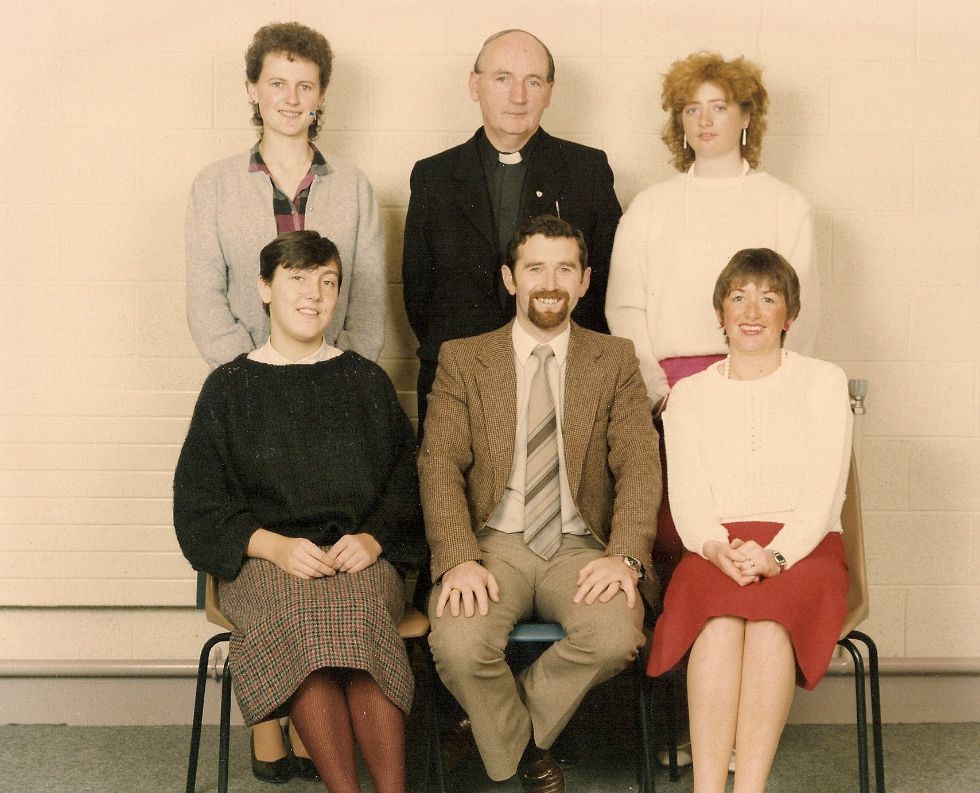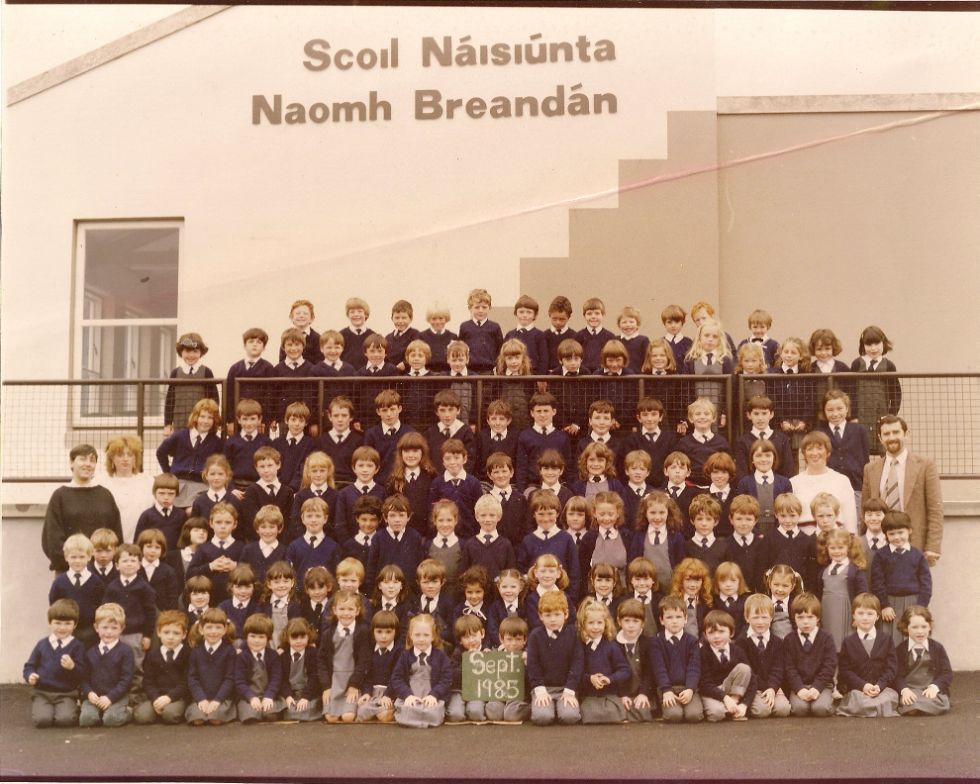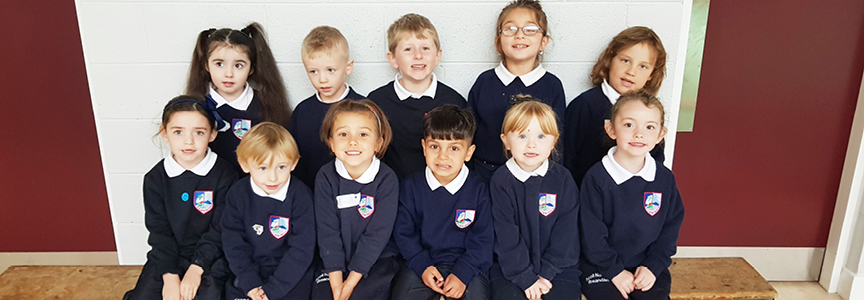History


St. Brendan’s National School opened its doors for the first time on the 1st September 1985 with an enrolment of 114 pupils and a staff of three teachers, including Principal, Eamonn Mullen and Deputy Principal, Mary Toolan. Classes operated from junior infants to second class that first year, and expanded to include pupils up to sixth class the following year. The school was the pride and joy of local residents of the Cartron housing estate, in which the school is located. They had campaigned and fund-raised for many years to have their own local school to cater for what was a rapidly-growing young population in the area. Fr. Seamus Cox was the original Chairperson of the Board of Management and he oversaw the school’s initial development as enrolment continued to grow until the early nineties when there were 310 pupils on roll and ten mainstream teachers! Every square inch of the
building was packed with class sizes over 40 quite common-place.
Eamonn Mullen retired in 2007 and was replaced by Marie Hurley. Marie Hurley retired in 2024 and has been replaced by exisiting Principal Ellie Kennedy.
Following Mrs Toolan’s retirement in 2010, Michael McDonnell became the Deputy Principal. He held the post until his retirement in Sept 2021, when Carmel Kenny took on the role.
Having been a member of staff since 1986, Ms Hurley has witnessed many of the changes to the physical and human environment in and around the school and the Cartron area. She often says that she grew up herself in the community!
The school was built on a site originally ear-marked for houses and as such the school is literally on the doorsteps of the Cartron community. It’s true to say that many a pupil of the area simply had to tumble out of bed at 9.00 am and across the road to make it to school by the 9.20 am starting bell! Its proximity to their home-life has meant that the school has been more than just an academic institution for many of our pupils who return year after year to have a chat with staff members and to reminisce about their primary school years in St. Brendan’s. School activities have played a central and unifying role in the neighbourhood. Many pupils have returned to live in the area in recent years and to enrol their own children in a school of which they held many fond memories.
The school was originally designed with 8 mainstream classrooms, located around a central and well-equipped PE hall. As it expanded, 2 porta-cabins were added to the rear of the building to cater for SEN pupils and in 2005 an Aftercare Service was opened by the Parents Association in one of the front classrooms and a purpose-built school playground installed. Sunset Aftercare has remained open since, catering for pupils until 6.00pm each evening
and running camps for pupils during school holiday periods.
There have been improvements and changes made to the original school building along the way. In 2011, all of the school’s toilets were refurbished and new shelving, flooring and storage were added to each classroom. In 2015, two ASD classes opened for enrolment and this year 2021 has finally seen the completion of an extension to the main school building to house a purpose-built, modern ASD unit and playground, a complete overhaul of electrical and heating services and extensions to the entrance and administrative areas. Coupled with a major investment in new school furniture in each classroom in 2018/2019, it has been the largest development in the school’s history, one that has dramatically improved the overall facilities the school has to offer.
Having originally functioned with 3 teachers for 114 children in 1985, it is a major sign of the changed educational landscape of Ireland, that the school has now 12 teachers and 9 SNAs on-site to cater in a decidedly more targeted way for the individual needs of a much more manageable current enrolment of 140-150 pupils. Ms Hurley often recalled the year back in the early 90s that she had “only” 39 pupils in her fifth and sixth class and thought she was blessed lucky!
One of the biggest changes in the school has been the move from the original blackboards and chalk in each classroom to the dawn of the digital era. From the original pieces of educational technology, the “stiallscannán” slide, film and overhead projectors, in 2008 the school purchased Interactive Whiteboards for each classroom. Broadband facilities had improved from the original single dial-up phone line to an ISDN line and then on to a fully networked, higher-speed system that brought the digital world into the classroom and opened the school to more modern teaching methodologies and learning opportunities. Banks of laptops and tablets were added and the school can now use mobile high-tech touch-screen TVs to add a bit of pizzazz to a modern-day assembly or Christmas sing-a-long and pupils can access a wealth of research materials for projects without leaving their seats. It was quite a poignant day when it was finally decided that the banks of old encyclopedia that graced the shelves of the school library were no longer needed or relevant for the modern pupil. And having been recycled for many years as notice boards, the refurbishment of 2020, eventually saw the departure of the original class blackboards. In recent times, the digital revolution continued apace with the dawn of the digital learning platforms and leaps forward in home-school communication by email, video-conferencing etc.
In 2022, St. Brendan's NS was officially awarded DEIS status- Urban DEIS 2 to be precise. DEIS stands for Delivering Equality of Opportunity in Schools.Through DEIS, the Government gives extra resources to schools where more support is needed.This gives all students every opportunity to learn, develop and achieve in school. Through DEIS, St. Brendan's was given access to the free School Meals Scheme, a shared Home School Community Liaison Scheme and extra funding for programmes and materials to ensure that pupils feel supported to attend school as often as possible and do well in literacy and numeracy in particular. School Completion Programme, a vital part of DEIS, had already been active in St. Brendan's since the late '90s.
All this is light-years away from where the school began in 1985. But through all the developments, one thing has remained constant: St. Brendan’s NS, although located in a large town, is very much a “local” school with its heart and purpose firmly rooted in the local area. It is a much-loved hub of education and activity and its central focus has always been the people, the children and finding ways to reach out to inspire them to be the best that they can be, to live happy and contented lives as children of the area and achieve their full-potential into adulthood.
Original teaching staff:
1985: Eamonn Mullen, Mary Toolan, Mary Rafferty, Teresa Doherty (later that year)
1986: Marie Hurley, Michael McDonnell
1987: Deirdre King, Brid Gaughan
1988: Anne-Marie Byrne, Mary McKinney
St. Brendan's National School, Sunset Drive, Cartron Point, Sligo, F91 YTK2
Phone: 071-9145449 | Registered Charity Number: 20134617

















